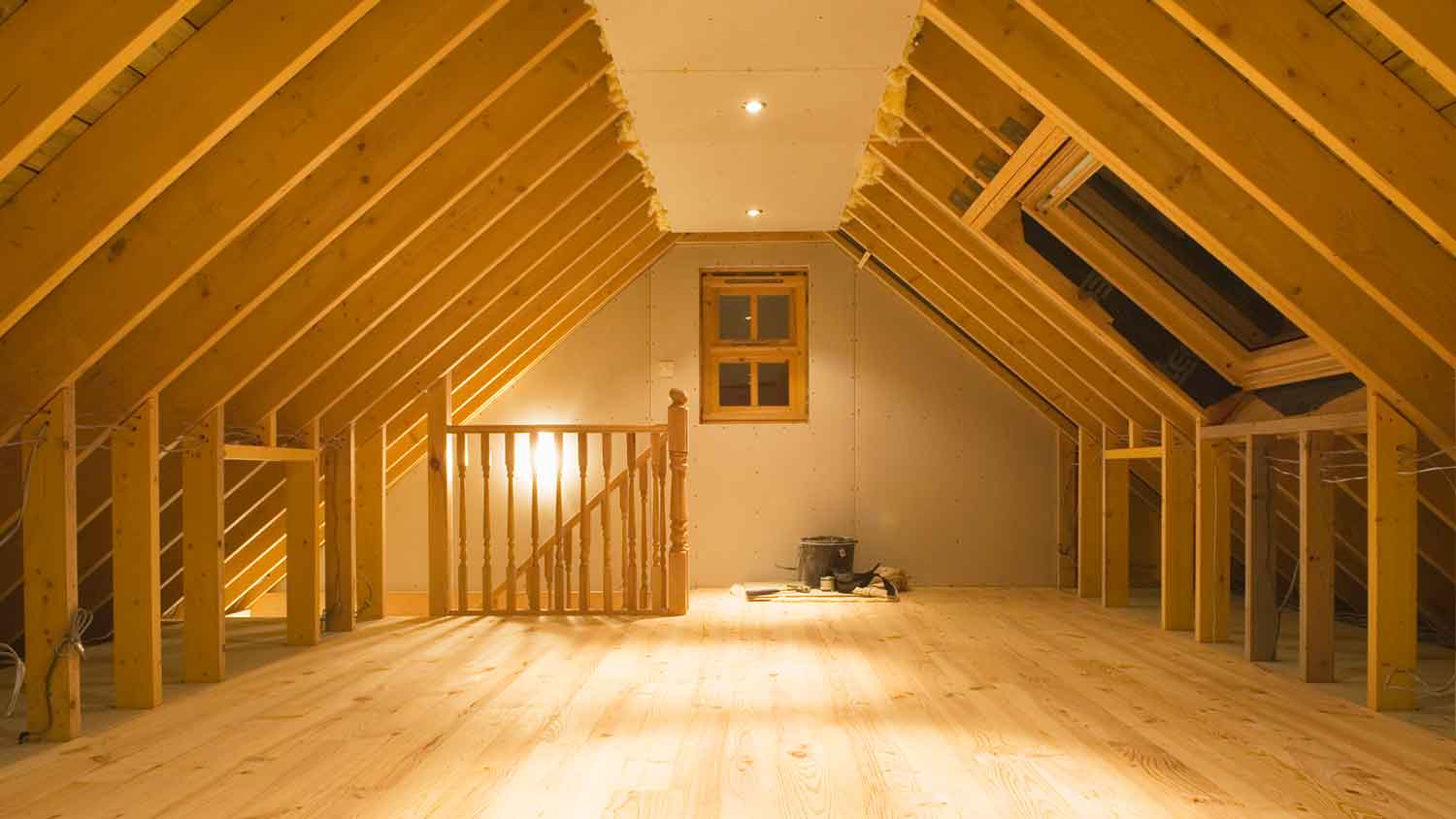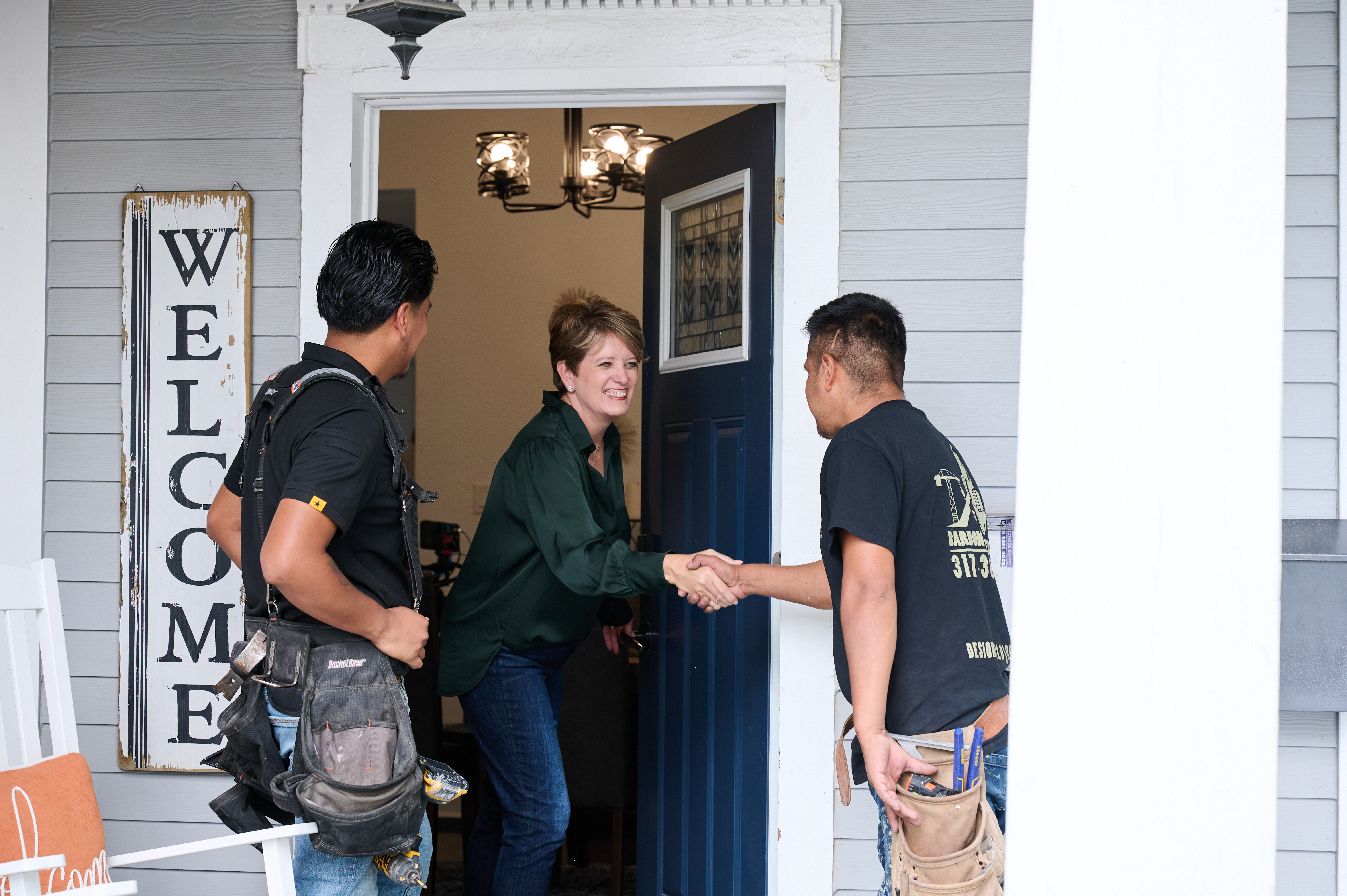
A bidet—stand-alone, attachment, spray nozzle, or toilet combo—reduces toilet paper usage and saves money, but how much is a bidet? Here’s how much you’ll pay.
The cost to install faux wood beams averages $3,000, with most homeowners spending between $1,500 and $4,000. Your price depends on beam size, material, ceiling height, and labor rates.


Faux wood beams offer a lightweight, decorative ceiling upgrade.
Project cost depends on beam size, material, and ceiling complexity.
Professional installation costs $40 to $100 per hour, ensuring secure mounting and a seamless appearance.
Faux beams are low-maintenance and do not require structural support.
Custom finishes and layouts can increase both cost and visual impact.
This article was created using automation technology and thoroughly fact-checked and edited by an Angi Editor in accordance with our AI policy.
The cost to install faux wood beams averages $3,000, with a range from $1,200 to $5,000, depending on the size and complexity of your project. Most installers charge per linear foot, with prices ranging from $15 to $35 per linear foot. Material, ceiling height, and labor rates all impact your final cost.
Faux wood beams are a popular way to add warmth and architectural detail to a room without the weight or expense of real wood. This guide covers everything you need to know about costs, options, and how to get the best value for your project.
How many beams you install and their dimensions have a direct impact on your project’s total cost. A small room with a single accent beam will cost much less than a great room with a full ceiling grid. Beam length, width, and depth all factor into material costs, while ceiling height and room shape can increase labor if installation is challenging.
For example, a compact bedroom might need only one or two short beams, while an open-concept living area or vaulted ceiling could require several long beams in a pattern. The complexity of your layout—such as adding a coffered ceiling or a herringbone pattern—also increases the price due to the added materials and labor.
| Project Size | Room Type | Number of Beams | Average Cost Range |
|---|---|---|---|
| Small | Bedroom, hallway, entryway | 1–2 | $1,200–$2,000 |
| Medium | Living room, dining room | 3–5 | $2,000–$3,500 |
| Large | Great room, vaulted ceiling | 6+ | $3,500–$5,000 |
Faux wood beams are available in a range of materials, each with its own cost and appearance. Polyurethane is the most common, offering a realistic wood look, light weight, and moisture resistance. High-density foam is similar but may be less durable. Medium-density fiberboard (MDF) and PVC beams are also options, with PVC best for humid spaces.
Material choice affects both your budget and the final look of your ceiling. Hollow beams are lighter and easier to install than solid beams, which are less common for faux products but may be used for custom work. Custom sizes, finishes (such as hand-hewn or distressed), and stains or paint can all increase your total cost.
Consider the pros and cons of each type in terms of durability, installation, and maintenance. Some beams come ready to install, while others need finishing on-site.
| Beam Material | Appearance/Finish | Cost per Lin. Ft. | Pros | Cons |
|---|---|---|---|---|
| Polyurethane | Wood grain, stained | $15–$25 | Lightweight, realistic, moisture resistant | May dent if hit hard |
| High-density foam | Smooth or wood grain | $12–$20 | Very light, easy to cut, affordable | Less durable, limited finish options |
| MDF | Smooth, paintable | $12–$18 | Paintable, budget-friendly | Not moisture resistant, less realistic |
| PVC | Smooth, wood-look | $18–$30 | Best for humid areas, durable | Fewer finish options, higher cost |
| Custom solid core | Hand-hewn, distressed | $25–$35+ | Unique, premium look | Heavy, expensive, complex install |
Where you live and where you want your faux wood beams installed can influence your total cost. Urban areas and high-cost states often see higher labor rates and material markups. Rural areas may have lower rates but less access to specialty installers, which can impact options and scheduling.
The location inside your home matters too. Installing beams on a standard living room ceiling is less expensive than working on a vaulted ceiling or in a basement with limited access. Multi-story installations or hard-to-reach areas can add both labor and equipment fees.
Several factors influence the total cost of installing faux wood beams. Let’s examine each area that can impact your price.
Faux wood beam installation is handled by carpenters, general contractors, or specialty ceiling installers. Labor rates range from $40 to $100 per hour or $5 to $15 per linear foot, depending on your region and the installer's expertise. For small projects, minimum service fees may apply, which can increase the cost of beam installation.
Ceiling height and layout complexity also play a role. Higher ceilings or elaborate beam patterns require more time and skill, increasing labor costs. Regional differences play a role, with higher rates in urban areas and coastal states.
Permits for faux wood beam installation are rarely required unless you’re making structural changes or need to comply with fire codes in multifamily buildings. Permit costs, if required, range from $50 to $200. Always check with your local building department to confirm requirements. If a permit is needed, the contractor often handles the process, but homeowners should verify who is responsible.
Customizing your faux wood beams with finishes, stains, or paint adds to the cost—expect to pay $2 to $5 per linear foot for finishing. Integrating lighting, ceiling fans, or HVAC vents may require special cuts and coordination with electricians or HVAC pros, costing an additional $200 to $500 per fixture.
Decorative hardware, such as corbels or brackets, can range from $30 to $150 each. Unique layouts, such as herringbone or coffered designs, may increase labor and material costs by 20% or more.
Project complexity, such as installing beams on vaulted or angled ceilings, increases costs due to the need for extra planning and labor. Accessibility issues—such as working around light fixtures or in tight spaces—can add to the price. Site preparation, including the removal of old beams or ceiling features, delivery fees, and debris disposal, may incur an additional cost of $100 to $500.
Post-installation cleanup and finishing touches are sometimes included, but check with your installer. If your design requires a consultation with an architect or designer, expect to pay fees ranging from $100 to $500. In rare cases, inspections may be required, especially in multifamily or HOA-governed properties.
Beyond installation, there are a few additional costs to consider when planning your faux wood beam project.
Many faux wood beam manufacturers offer warranties covering materials and finish, lasting 10 to 20 years. Professional installers may warranty their workmanship for one to five years. Opting for extended warranties or premium finishes can increase your total cost, but it can also provide peace of mind.
Routine cleaning for faux wood beams involves dusting or wiping with a damp cloth. Over time, you should touch up paint or stain, which can cost $50 to $150 for materials. Compared to real wood beams, faux beams are lower maintenance since they resist warping, cracking, and pests.
Sales tax applies to both materials and installation services in most areas. Local tax rates vary, adding between 5% and 10% to your total project cost. Always factor this in when budgeting for your faux wood beam installation.
Some homeowners consider installing faux wood beams themselves to save on labor. DIY installation requires purchasing the necessary materials, including beams, fasteners, adhesives, and tools such as a saw, drill, and ladder. Material costs remain the same, but you’ll save on labor. Dedicated DIYers should budget $100 to $300 for tools and safety gear, if they do not already own them.
DIY installation is best for those with solid carpentry skills, as improper mounting can lead to sagging, safety hazards, or voided warranties. Projects involving high ceilings or complex layouts are safer and more successful when handled by a local handyperson.
| Installation Method | Total Cost | Pros | Cons |
|---|---|---|---|
| DIY | $1,300–$3,300 | Save on labor, flexible schedule | Risk of mistakes, safety hazards, no warranty |
| Pro | $2,200–$5,000 | Professional finish, warranty, and less hassle | Higher cost, must schedule with the installer |
Deciding to repair or replace faux wood beams depends on the extent of the damage. Minor issues—like scratches, small cracks, or loose mounting—can often be repaired for $100 to $400. If beams have major cracks, structural failure, water damage, or an outdated look, replacement is the better option.
The "50% rule" is a helpful guideline. If repair costs exceed half the price of a new installation, replacement is a more cost-effective option. Also, consider the age and warranty status of your beams. Assess the damage carefully; if beams are sagging or detached, replacement ensures safety and a better appearance.
Installing faux wood beams can enhance your home’s value by improving its visual appeal and creating a high-end, custom look. Many buyers are attracted to the warmth and character that beams add, especially in open-concept living spaces. While the return on investment varies, well-installed faux beams often yield a strong ROI compared to other decorative ceiling upgrades.
The quality of installation, thoughtful design, and how well the beams complement your home’s style all influence value. Faux beams offer the benefits of real wood—such as architectural drama without the maintenance or weight —making them a smart, functional, and beautiful choice for a range of homes.
To keep your project cost-effective, consider the following tips:
Choose standard sizes and finishes to reduce material costs.
Install beams in accessible, lower-ceiling areas to minimize labor.
Bundle installation with other ceiling or remodeling projects.
Get multiple quotes from qualified installers for competitive pricing.
Consider partial DIY (e.g., painting or staining beams before installation).
Schedule installation during off-peak seasons for potential discounts.
Reuse or repurpose existing beams if possible.
Home is the most important place on earth, which is why Angi has helped more than 150 million homeowners transform their houses into homes they adore. To help homeowners with their next project, Angi provides readers with the most accurate cost data and upholds strict editorial standards. We extensively research project costs to develop the pricing data you see, so you can make the best decisions for you and your home. We rely on reputable sources, including the U.S. Bureau of Labor Statistics, academic journals, market studies, and interviews with industry experts—all to ensure our prices reflect real-world projects.
Want to help us improve our cost data? Send us a recent project quote to [email protected]. Quotes and personal information will not be shared publicly.
When two of my wired smoke detectors failed shortly after their ten-yr lifespan expiration I contacted Jerry to replace all of them. He came out the next day, did the work efficiently, and tested the system. He even ferreted out the circuit they were on for future reference. His final charge...
They did my kitchen backsplash and it looks so beautiful, I am so pleased with it. They are very quick but do a great job. The customer service was great. Matt, Lexi and Andrea are such nice people!!
Out of several companies I called for snow removal service they were the first to call back and were able to get out to us quicker than I had initially expected!
In todayâ s world it hard to find service and trade professionals that know how to communicate and do what they say they are going to do. Gian was prompt, respectful, and kept me apprised of his status and arrival times. Few others were even willing to bid my small gutter repair and...
Can’t say enough about the service I received. My garage door springs broke late yesterday afternoon with cars inside. I started calling places for help and two places told me it would be two or three weeks for service! I called Cascade and was told they could fix it today. The gentleman...
They were very professional, prompt, efficient and left the job very clean. I would strongly recommend Mallory Tree and Yard service.
Columbia Basin Fence was excellent and very easy to deal with from the bidding process to the final project they hold them selves to a high quality product and very good customer service!
It's been a pleasure to work with the R3 Homes team. They run their business with honesty and integrity and Jim went above and beyond to make sure we were satisfied with their snow removal services, and we are!
I hired Ray to repair my shower door, he was here about 45 minutes and paid him $65.00, I appreciated the prompt service!
Great service, and great job. Got here right on time, was able to complete the job very efficiently. I asked if they could also install a sink stopper, and they did that too.
From average costs to expert advice, get all the answers you need to get your job done.

A bidet—stand-alone, attachment, spray nozzle, or toilet combo—reduces toilet paper usage and saves money, but how much is a bidet? Here’s how much you’ll pay.

A bidet—stand-alone, attachment, spray nozzle, or toilet combo—reduces toilet paper usage and saves money, but how much is a bidet? Here’s how much you’ll pay.

Discover wheelchair ramp cost estimates, including installation, materials, and tips to save. Learn what impacts your price and how to budget for your project.

Whether you need to hang a picture or mount a TV, this step-by-step guide on how to drill into brick will make the entire process a breeze.

Hiring the right handyperson can save you time and even money. Here are the best tips for hiring any home project, plus interview questions for a handyperson.

Both a handyman and contractor serve different purposes for your home projects. This guide will help you hire the right professional for your unique job.